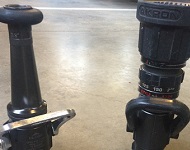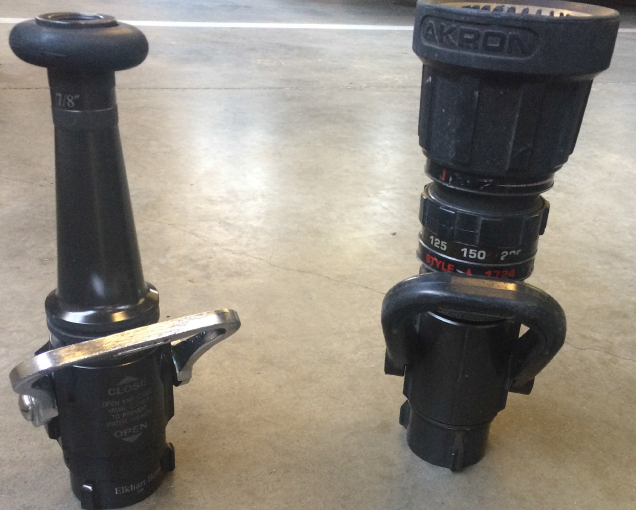
By Brian Zaitz
The nozzle is the most fundamental aspect of the fire service; its symbol alone practically represents the job of firefighting. How much time do we dedicate to knowing it, checking it, and understanding it? Too often, the nozzle is checked by looking at the hose and “checking” that the nozzle is on the line. Although this “checks” the placement, it does not ensure its serviceability or that it is correct. Being the “key players” in delivering water and extinguishing fire, the nozzle and the hose deserve a little more attention than just a visual inspection.

When inspecting the nozzle, uncouple it from the line and check the threads on the inside of the coupling connection. Are the threads good? Is there grit or sand present that would lead to a poor connection? Is the gasket present, and is it still pliable and not dry-rotted? Check the bale; is it cracked, and does it move freely from open to close? Does the valve inside the nozzle function with the bale, meaning that the actions associated with opening and closing are actually taking place?
Check the teeth; are they present, and is there debris that would obstruct flow? If it is a smooth-bore, is the tip the correct size? Last, inspect the overall condition; is the nozzle damaged, broken, or showing excessive signs of wear? If so, replace it!!

Again, this is your water delivery system. The time to find out that it is corrupted is not while you are moving into a well-involved room and needing to flow water. On completion, recouple the nozzle, then pull the line and repack it. This will ensure that you are ready for the alarm and that the entire package, hose load, and nozzle are exactly up to your specifications.
As important as it is to check your nozzles, it is just as important to know what nozzles you have and what options they afford. For many of us, our handlines are equipped with either a solid bore or combination nozzle, so know the difference and understand the advantages and limitations of each. If you have smooth bores, learn how to hydraulically ventilate with them (yes, it can be done!). If you have fog nozzles, know which direction to turn the nozzle to go from wide fog to smooth bore. Again, the time to find these things out is not on the scene of an alarm.
RELATED: Connors on Smooth-Bore Nozzles | Nemick on the Combo Nozzle | Shaw and Mitchell Jr. on the Last Line of Defense
In addition, there are a variety of other nozzles, such as ground monitors, that provide large volumes of water from unmanned nozzles. These are great options for defensive fire conditions or exposure protection. Ladder pipe nozzles also flow high volume water and can provide that placement to areas that are not easily accessible by ground crews.

It is important to practice and understand the volume of what these nozzles can flow as well as what water supply you will need for their extended operation. There is also the piercing nozzle, which provides access through walls, roofs, and other solid materials, allowing for quick water application to the burning materials. The foam nozzle, although more an attachment, entrains air into the foam/water mixture to create a better foam solution and foam blanket. Understand these nozzles, and know their location and their appropriate application.
The nozzle is the backbone tool of the fire service and, like anything else, it is imperative that you know your tools, inspect them, clean them, and use them for what they were designed to do. Take time on your next tour to inspect your nozzles and review their functionality.
Download this training bulletin as a PDF HERE (3.8 MB)
 Brian Zaitz is a 14-year student of the fire service, currently assigned as the captain/training officer with the Metro West (MO) Fire Protection District. Brian is an instructor with Engine House Training, LLC as well as instructor at the St. Louis County Fire Academy. Brian holds several degrees, including an associates in paramedic technology, a bachelors in fire science management, and a masters in human resource development. Brian is currently and accredited chief training officer and student of the National Fire Academy’s Executive Fire Officer Program.
Brian Zaitz is a 14-year student of the fire service, currently assigned as the captain/training officer with the Metro West (MO) Fire Protection District. Brian is an instructor with Engine House Training, LLC as well as instructor at the St. Louis County Fire Academy. Brian holds several degrees, including an associates in paramedic technology, a bachelors in fire science management, and a masters in human resource development. Brian is currently and accredited chief training officer and student of the National Fire Academy’s Executive Fire Officer Program.
MORE THROW BACK TO BASICS

